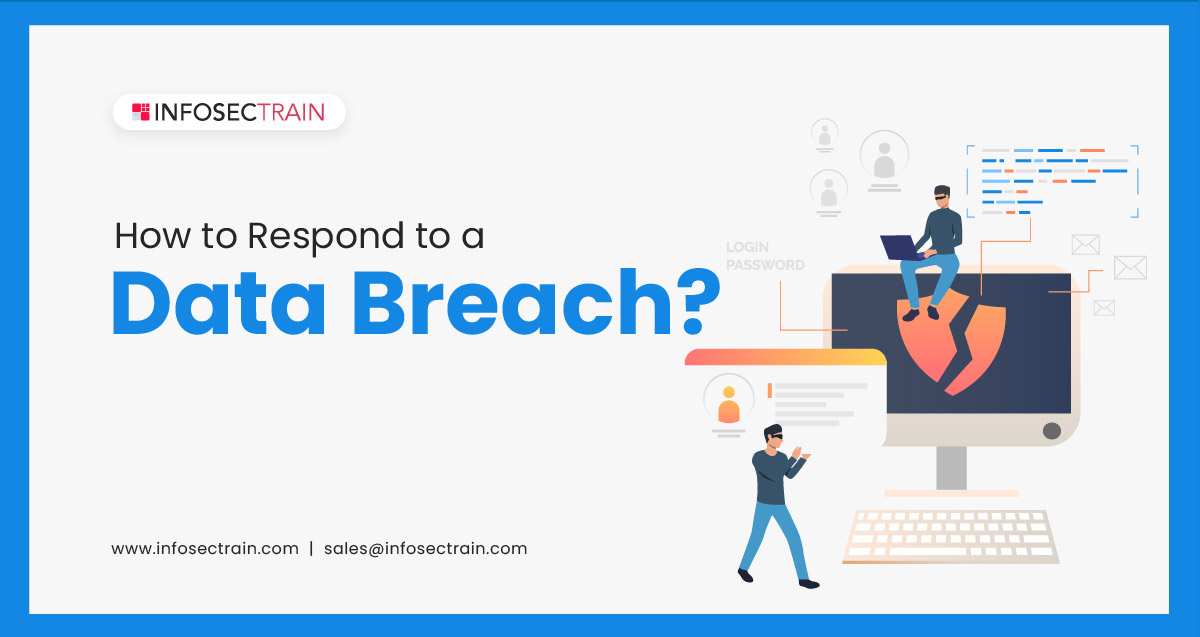How to Respond to a Data Breach?
India is ranked among the top five countries in the world for cyberattacks. We have been experiencing a significant rise in cyber-attacks every day; among them, data breaches are numerous. When a data breach has happened, instead of being panicked or surprised, it is essential to prepare a preliminary plan to respond to the data breach. It helps to avoid legal, reputational, and financial repercussions and can protect other systems from the affected systems much faster.

Table of Contents
What is a Data Breach?
How to respond to a Data Breach?
How to Prevent Data Breaches?
Train your employees with InfosecTrain
In this comprehensive blog, we will check out critical steps in the process of responding to a data breach. Before digging into it, let’s rewind our basics on What is a Data Breach?
What is a Data Breach?
A Data Breach (also known as a data leak) is a security incident in which an unauthorized user has stolen, accessed, copied, and disclosed confidential or sensitive data. It can be an accidental data leak or intentional disclosure of data leading to considerable losses to the company.
The company’s data can include confidential information such as individual identity, credit card details, trade secrets, or customer data. The Data Breach can affect the company’s trust among customers, and they might suffer substantial financial losses.
How to respond to a Data Breach?
If you have experienced a data breach, this guide will be your template to take action according to the breach activity. Now, let’s go through each step and understand the objectives.
1. Identify the Breach
The first step of the investigation is to identify the data breach. It helps to define, determine, and prioritize the data breach effect. Various warnings represent the signs of a data breach. They are as follows:
- A message from the attacker like Ransomware
- Identifying unusual software installed in the system
- Alerts from malware protection software
- Unusual Configuration changes
- Repeated system crash
- Destructive behavior of the system while browsing, such as ad pop-ups, etc
Some tools are used to identify the causes of a data breach, such as Intrusion Detection Systems (IDS) that help determine the network’s behavior.
2. Stop the Breach
After identifying the root cause of the data breach, it is important to patch the source of the data leak. It helps to stop the process of transmitting the data to the attacker. Also, it is essential to isolate the affected system from the network and discard the accounts that are the data leak sources. Ensure the data leak is stopped by the end of this step.
3. Analyze the Data Breach
Based on the facts about the data breach, such as the potential impact on the customer’s data and reputational damage, it is time to implement a response plan. The following are the points that need to be considered while analyzing the data breach:
- Take business operations offline to prevent further data losses
- Fix the identified vulnerabilities
- Secure the affected area to control access to data breach evidence
- Alert members of the response team
- Call the cyber forensics team to begin investigations into when and how the cyber attack happened
- Consult with the legal team and inform the law enforcement if necessary
- Notify the cyber liability insurance provider
4. Notify Affected Parties
Now, inform the affected customer that a security violation has happened in the organization and resulted in a data leak. Spreading awareness among the customers helps to protect themselves from a huge impact. This step is significant, but usually, people try to omit it to preserve their reputation. Rather than covering up the issue, being honest with the customers is the best way. With the rise in cyber threats, customers understand that no company can provide 100% security, and 100% security is merely a myth.
5. Perform a Security Assessment
Security Assessment is necessary to ensure that there is no risk to data. It provides a complete data security audit, a list of vulnerabilities, and areas for improvement. A proper security assessment will help to enhance the company’s security posture that proactively prevents data breaches in the future.
6. Finish with a Process Review
Lastly, organizations should update the recovery plan with the latest processes and steps. The data breach incident will potentially become an authentic and practical learning experience if things are placed correctly. It helps the response team to derive new security policies to protect the data from attackers.
Data breaches have been increasing continuously; companies are indulging effective strategies to develop a robust data breach recovery plan and combat cyber attacks.
How to Prevent Data Breaches?
The best way to protect data from cyber attacks is to prevent them. The following are well-known and highly ignored things organizations should consider seriously to overcome the data breach:
- Create and update the security policies and procedures regularly
- Patching and updating the software as required
- Maintain and implement the latest security software
- Protect portable devices with strong passwords
- Use multi-factor authentication to avoid unauthorized users
- Encrypt your data before transmitting
- Continuous monitoring of the network for unusual activities
- Regular data backup for easy recovery
- Educate the employees on handling sensitive data
Train your employees with InfosecTrain
Data breaches are the fastest-growing type of crime in the world, so it is essential to have appropriate cybersecurity expertise to protect your organization or yourself from these hazards. If you provide your employees with the necessary cybersecurity knowledge, you have a significant advantage in protecting your organization. InfosecTrain therefore offers the most rigorous professional cybersecurity training for both individuals and businesses. Working with our qualified cybersecurity experts will assist in protecting your organization from potential threats.







 1800-843-7890 (India)
1800-843-7890 (India)